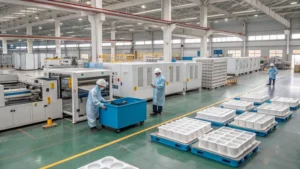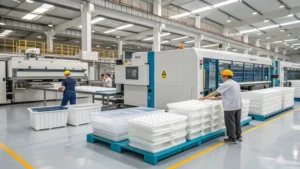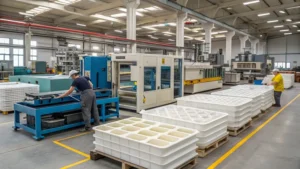
Plastic vacuum forming is a versatile manufacturing process1 that transforms flat plastic sheets into three-dimensional shapes using heat and vacuum pressure. This method is widely adopted for its cost-effectiveness and ability to produce both small and large batches of parts with consistent quality, making it essential across industries like packaging, automotive, and medical.
Vacuum forming heats plastic sheets2 and uses a vacuum to shape them over molds, creating durable, lightweight products for packaging, automotive, and medical applications.
In this blog post, we’ll explore Ireland’s leading formación al vacío3 factories, the materials and processes involved, and the diverse applications of this technology.
Vacuum forming reduces material waste compared to other methods.Verdadero
The process uses pre-cut sheets, minimizing excess material, and any waste can often be recycled.
Vacuum forming is only suitable for small parts.Falso
Vacuum forming can produce large parts, such as automotive dashboards or signage, making it versatile for various sizes.
- 1. What are the Top Plastic Vacuum Forming Factories in Ireland?
- 2. ¿Cuáles son los materiales más utilizados en el moldeo por vacío?
- 3. ¿Cuáles son los pasos del proceso de moldeo por vacío?
- 4. ¿Cuáles son los factores clave en el proceso de moldeo por vacío?
- 5. ¿Cuáles son las aplicaciones del moldeo por vacío?
- 6. How Does Vacuum Forming Compare to Other Methods?
- 7. Conclusión
What are the Top Plastic Vacuum Forming Factories in Ireland?
Ireland hosts a select group of elite vacuum forming factories known for their expertise and industry impact. Below are seven standout companies driving this sector forward.
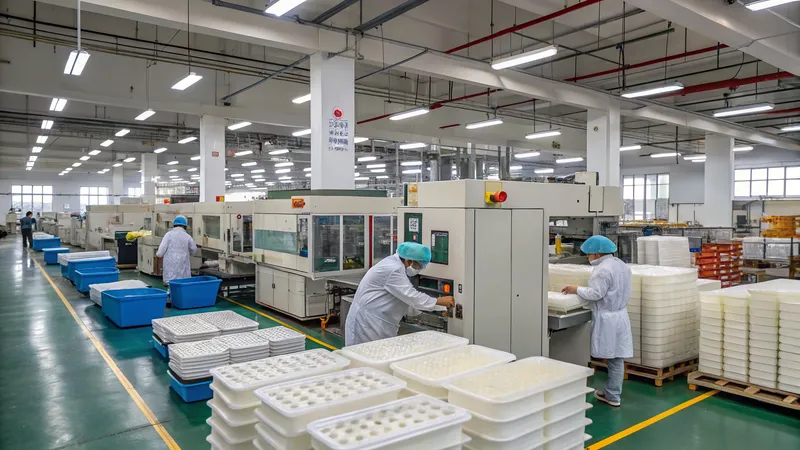
Ireland’s top vacuum forming factories, including Enform Plastics and Collins Plastics Ltd, excel in producing custom parts for industries like medical, packaging, and aerospace.
| Company Name | Location | Specialties |
|---|---|---|
| Enform Plastics | County Clare, Ireland | Retail, medical, pharmaceutical, heavy industry vacuum forming |
| Collins Plastics Ltd | Ballina, Co. Mayo, Ireland | Display stands, signage, shop displays, custom fabrication |
| Future Plastics Group | Navan, Co. Meath, Ireland | Heavy-gauge vacuum forming for aerospace, industrial applications |
| Consort Case Company | Mooncoin, Co. Kilkenny, Ireland | Custom vacuum forming for medical, electronics, marketing |
| AiP Thermoform Packaging | Ennis, Co. Clare, Ireland | Thermoformed packaging (clamshells, trays) for electronics, pharmaceutical |
| Mannok Pack | Ballyconnell, Co. Cavan, Ireland | Vacuum-formed food packaging (trays, containers) |
| Donite Plastics Limited | Northern Ireland | Large-scale vacuum forming for automotive, aerospace, medical |
These factories leverage advanced equipment and skilled teams to meet diverse client needs, solidifying Ireland’s reputation in vacuum forming excellence.
¿Cuáles son los materiales más utilizados en el moldeo por vacío?
The choice of material in vacuum forming is critical, as it determines the final product’s strength, flexibility4, and suitability for specific uses.

Vacuum forming uses termoplásticos5 like ABS, acrylic, and polystyrene for their durabilidad6, transparency, and versatility in applications from packaging to aerospace.
| Material | Propiedades clave | Usos comunes |
|---|---|---|
| ABS | Duradero y resistente a los golpes | Piezas de automóviles, bienes de consumo |
| Acrílico (PMMA) | Transparent, optically clear | Signage, medical devices |
| Poliestireno (HIPS) | Cost-effective, rigid | Packaging, displays |
| Policarbonato | Heat-resistant, strong | Safety equipment, aerospace |
| Polipropileno | Flexible, resistente a productos químicos | Containers, living hinges |
| HDPE | Stiff, durable | Outdoor applications, containers |
| PVC | Versatile, chemical-resistant | Envases, bandejas |
-
ABS: Ideal for rugged applications due to its toughness.
-
Acrylic: Chosen for its clarity in visual products.
-
Poliestireno: A budget-friendly option for lightweight items.
PVC is the most commonly used material in vacuum forming.Falso
While PVC is widely used, materials like ABS and polystyrene are also prevalent depending on the application.
¿Cuáles son los pasos del proceso de moldeo por vacío?
Vacuum forming follows a precise sequence of steps to transform plastic sheets into functional shapes.
The vacuum forming process involves mold creation, heating plastic sheets, applying a vacuum, and cooling to produce parts for various industries.
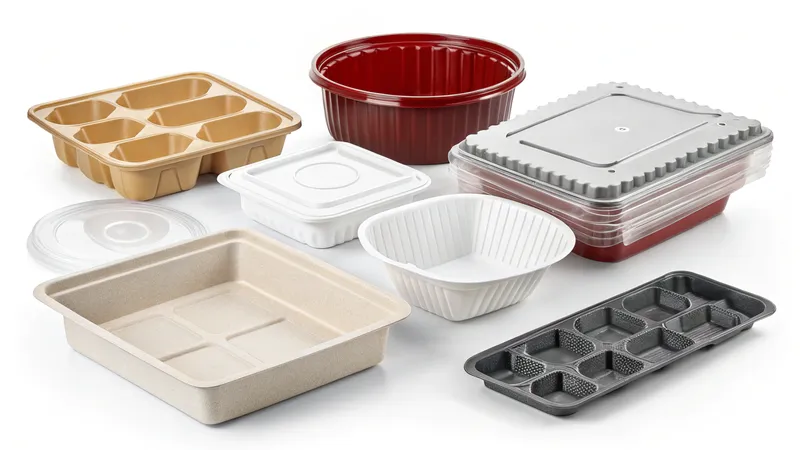
-
Mold Creation: Molds, often made from aluminum or wood, define the part’s shape.
-
Selección de materiales: A thermoplastic sheet is chosen based on the product’s needs.
-
Calefacción: The sheet is heated to a pliable state, typically in an oven.
-
Formando: A vacuum pulls the heated sheet over the mold to form the shape.

-
Refrigeración: The part cools and solidifies, often aided by fans.
-
Recorte: Excess material is removed, and finishing touches are added.
Each step demands precision to ensure quality and consistency.
¿Cuáles son los factores clave en el proceso de moldeo por vacío?
Several variables influence the success of vacuum forming, impacting the final product’s quality.
Mold design7, heating temperature, and vacuum pressure are critical factors in vacuum forming, affecting part detail and durability.
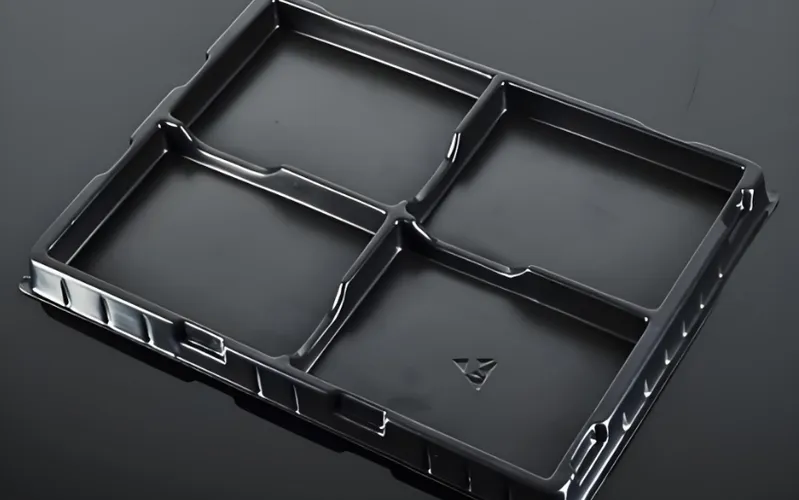
-
Diseño de moldes: Proper angles and finishes ensure easy removal and detail accuracy.
-
Temperatura de calentamiento8: Must be optimal to avoid thinning or tearing.
-
Presión de vacío9: Needs to be strong enough for precise molding.
-
Métodos de refrigeración: Uniform cooling prevents warping.
High vacuum pressure always improves part quality.Falso
Excessive pressure can distort details or damage the plastic, requiring a balanced approach.
¿Cuáles son las aplicaciones del moldeo por vacío?
Vacuum forming serves a broad array of industries with its ability to produce cost-effective, durable parts.
Vacuum forming is applied in packaging, automotive, and medical fields, creating trays, dashboards, and device casings efficiently.
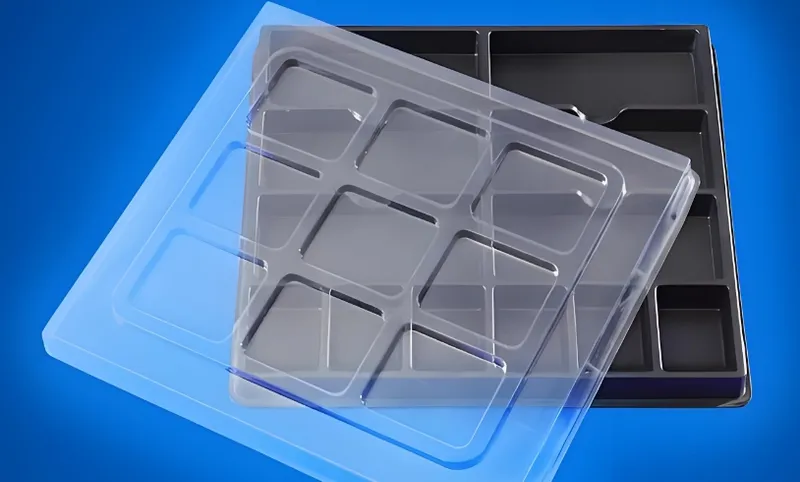
-
Embalaje: Blister packs and food trays.
-
Automoción: Dashboards and interior trim.
-
Médico: Sterile trays and protective cases.
-
Señalización: Eye-catching displays.
Its versatility makes it a go-to solution for both small and large-scale production.
How Does Vacuum Forming Compare to Other Methods?
Vacuum forming stands out among plastic forming techniques, but its suitability depends on the project.

Vacuum forming offers lower tooling costs and faster setup than injection molding, excelling in large-part production.
| Método | Pros | Contras |
|---|---|---|
| Moldeo por vacío | Low cost, large parts, quick setup | Uniform thickness, less detail |
| Moldeo por inyección | High precision, complex shapes | High tooling cost, smaller parts |
| Impresión 3D | Flexible design, small runs | Slower, limited material strength |
Vacuum forming is less precise than injection molding.Verdadero
Injection molding offers finer details, while vacuum forming prioritizes cost and speed.
Conclusión
Ireland’s top vacuum forming factories, such as Enform Plastics y Future Plastics Group, showcase the power of this process in delivering innovative, cost-effective solutions. By mastering materials, process steps, and key factors, these companies meet the demands of diverse industries.
-
Learn about the detailed steps in the vacuum forming manufacturing process to gain insights into how products are made efficiently. ↩
-
Discover the different types of plastic sheets suitable for vacuum forming, which can help you choose the right materials for your projects. ↩
-
Explore este enlace para comprender el proceso de conformado al vacío y sus aplicaciones en diversas industrias, mejorando su conocimiento de las técnicas de fabricación. ↩
-
Discover the significance of flexibility in vacuum forming materials and how it enhances product functionality and design. ↩
-
Explore the advantages of thermoplastics in vacuum forming to understand their impact on product quality and application versatility. ↩
-
Learn how durability influences material choices in vacuum forming, ensuring optimal performance for various applications. ↩
-
Comprender el diseño de moldes es crucial para conseguir productos conformados al vacío de alta calidad. Explore las ideas de los expertos para mejorar sus diseños. ↩
-
Heating temperature plays a vital role in the vacuum forming process. Learn how to optimize it for better results. ↩
-
Vacuum pressure is essential for precise molding. Discover its significance and how to measure it effectively. ↩



